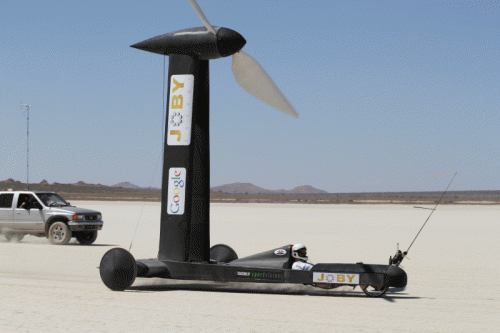Photograph of the land yacht Blackbird. Image: Stephen Morris
(Phys.org) -- This month’s news-making word in wind-powered vehicle experiments is “upwind.” Blackbird, a wind powered cart, has shown it can travel upwind at more than twice the speed of circulating air. Rick Cavallaro, an aerodynamicist focused on designing record-setting vehicles that challenge wind speed, first made news two years ago when his Blackbird vehicle raced downwind at 2.86 times the speed of the wind. This time, after modifying his cart, he and his Blackbird team went out to the New Jerusalem airport in Tracy, California, where the vehicle achieved a top speed 2.01 times faster than the wind speed when headed upwind.
Overall, the key modifications that made a downwind Blackbird ready to take on an upwind run included the substitution of the propeller with a turbine that rotates in the opposite direction and transmits power to the wheels.
“After a very long sabbatical, we're finally building some momentum on making our downwind cart go directly upwind faster than the wind,” Cavallaro had reported in the early days of his upwind project.
“We'll use the same vehicle,” he said, but the propeller will come off and will be replaced by a turbine. “The turbine will look very much like the propeller, only hopefully nicer, and with the opposite twist and camber.” He explained that the wind would turn the turbine and that would turn the wheels, “sending us upwind faster than the wind, steady-state. The turbine will also turn the opposite direction from the prop so we can again take advantage of the long left axle to keep us from overturning the Blackbird at speed.”
Cavallaro also had to work out a way to prevent the turbine’s torque from flipping the vehicle over. As a solution, he designed one of its axles as longer than the other, and the Blackbird’s chain drive was reconfigured to fit the asymmetrical axle setup.
The principle behind the upwind-configured Blackbird is similar to that of sailing. Blackbird’s version of two large sails are its turbine blades, spinning around a common axis, moving forward as the cart sails into the wind and cross-wind as the blades turn around the axis.
He said the combination of upwind and cross-wind motion is identical to that of a sail on a boat on an upwind tack. The sailboat makes use of its keel to constrain the motion of the sail in the correct direction, and in Blackbird’s case, the transmission and wheels perform the same function.
Cavallaro holds the title of Sportvision Chief Scientist and he holds 25 patents in computer enhancement of live sporting events. He received a B.S. in Aerospace Engineering from Georgia Tech and M.S.in Dynamics and Controls from UCLA and worked in aerospace for several years.
More information:
via Wired
© 2012 Phys.org























